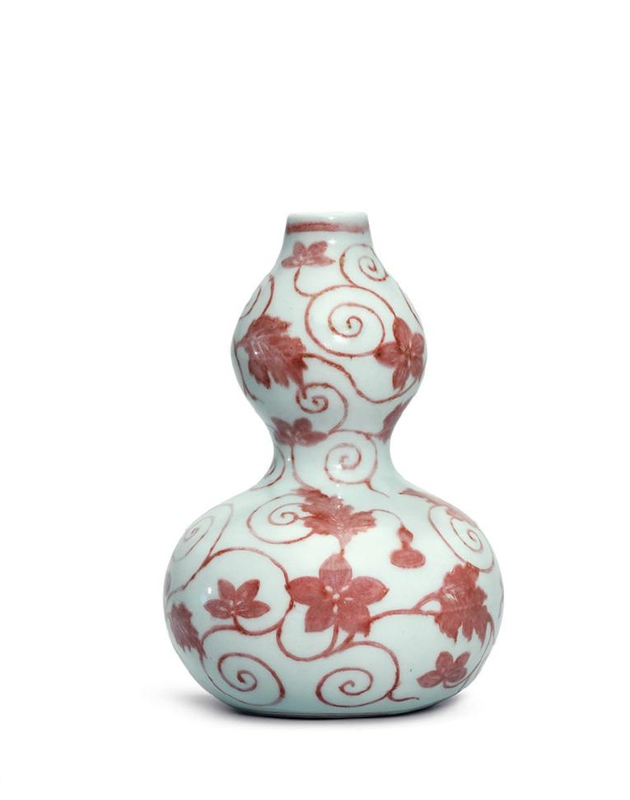A fine and rare Ming-style copper-red double-gourd vase, Kangxi period (1662-1722)
Lot 3331. A fine and rare Ming-style copper-red double-gourd vase, Kangxi period (1662-1722). Estimate HK$4,500,000-5,000,000 (US$590,000-650,000). Unsold. Photo Christie's Image Ltd 2016.
The finely potted vase is elegantly painted around the exterior with gourd flowers and fruits emerging from curling tendrils. The veining of the petals and leaves are lightly incised in the body; the copper-red are of an even bright burgundy tone, while the countersunk base is unglazed. 7 1/8 in. (18 cm.) high
Provenance: The Mrs. Alfred Clark Collection; sold at Sotheby’s London, 24 March 1953, lot 27
The J. T. Tai Collection; sold at Sotheby’s Hong Kong, Masterpieces of Qing Imperial Porcelain from J.T. Tai & Co., 7 October 2010, lot 2133
Notes: The current vase is inspired by Ming blue and white vases of the same form and design. Blue and white double-gourd vases first appeared during the Yuan dynasty, when they were more often produced in larger sizes. For a blue and white double-gourd vase of comparable size, see a Xuande example in the British Museum, illustrated by Jessica Harrison-Hall, Ming Ceramics in the British Museum, London, 2001, no. 4:18, and another from the E.T. Chow Collection, included in A Loan Exhibition of One Hundred Selected Masterpieces, Osaka, 1961, no. 63, illustrated as Ming, but sold as 17th century at Sotheby’s Hong Kong, 19 May 1981, lot 541. Another example was formerly in the collections of N.V. Hammer and John D. Rockefeller III, later sold at Christie’s New York, 15 September 2015, lot 426, dated Kangxi to Yongzheng periods or earlier. Compare also to a similar Jiajing blue and white double-gourd vase in the Palace Museum, Beijing, illustrated by Geng Baochang, Gugong bowuyuan cang gutaoci ziliao xuancui, vol. 1, Beijing, 2005, no. 146. And a similar example in the collection of Mr. and Mrs. Walter Sedgwick, is illustrated in The Ceramic Art Of China and Other Countries of the Far East, London, 1945, Plate 95 (b), where it is dated Zhengde period.
Under the supervision of Lang Tingji, the director of the Imperial kilns at Jingdezhen between 1705-1712, successful copies of wares from earlier periods were made. Liu Tingji, an official serving in Jiangxi during the Kangxi period, notes in Zaiyuan zazhi [Miscellanea of the Zai Garden] that ‘Lang’s copies are almost the same as the original...those imitating Chenghua and Xuande can hardly be distinguished from the original, the colour of the glaze, the orange-peel texture, and the marks, are almost identical’. Lang Tingji is also accredited for the revival of copper-red glazes, which had been almost completely discontinued since the Xuande period. For these reasons, the current vase is most likely to have been made during Lang Tingji’s tenure.
Christie's. THE IMPERIAL SALE / IMPORTANT CHINESE CERAMICS & WORKS OF ART, 1 June 2016, Convention Hall

/https%3A%2F%2Fprofilepics.canalblog.com%2Fprofilepics%2F1%2F0%2F100183.jpg)
/https%3A%2F%2Fstorage.canalblog.com%2F03%2F02%2F119589%2F96711876_o.jpg)
/https%3A%2F%2Fstorage.canalblog.com%2F11%2F31%2F119589%2F94773502_o.jpg)
/https%3A%2F%2Fstorage.canalblog.com%2F20%2F83%2F119589%2F94772815_o.jpg)
/https%3A%2F%2Fstorage.canalblog.com%2F26%2F72%2F119589%2F75604929_o.jpg)
/https%3A%2F%2Fstorage.canalblog.com%2F59%2F60%2F119589%2F26458628_o.jpg)



/http%3A%2F%2Fstorage.canalblog.com%2F76%2F67%2F119589%2F127775966_o.jpg)
/http%3A%2F%2Fstorage.canalblog.com%2F65%2F81%2F119589%2F126448901_o.jpg)
/image%2F1371349%2F20240507%2Fob_6e4c73_telechargement-17.jpg)
/image%2F1371349%2F20240506%2Fob_75d035_telechargement-14.jpg)